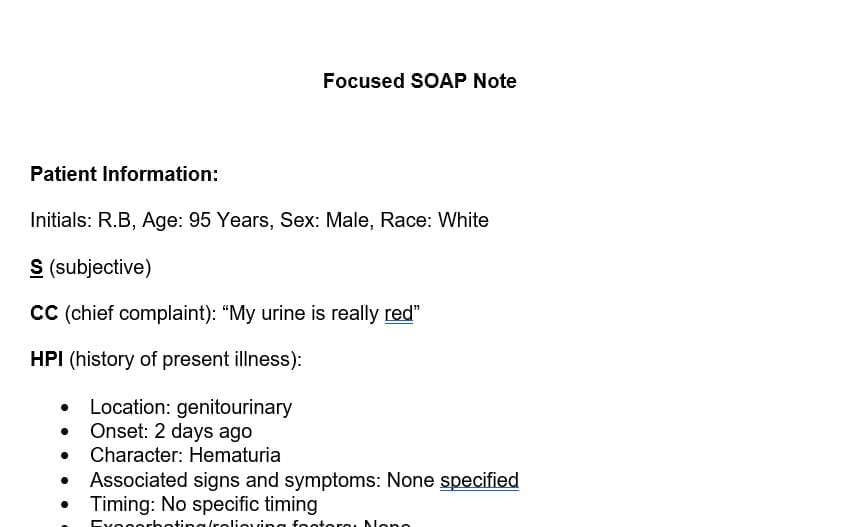R.B. is a 95-year-old, white male, currently living in a skilled nursing facility (SNF)
R.B. is a 95-year-old, white male, currently living in a skilled nursing facility (SNF)
R.B. is a 95-year-old, white male, currently living in a skilled nursing facility (SNF)
Chief complaint: “My urine is really red.”
HPI: On Wednesday (2 days ago) the patient was brought to your clinic by his son and complained that his urine appeared to be bright red in color. You ordered labs, urinalysis, culture, and sensitivity, and the results are below.
Allergies: Penicillin: Hives
Medications: Tamsulosin 0.4 mcg, 2 capsules daily, Aspirin 325 mg daily, Atorvastatin 10 mg 1 tablet daily, Donepezil 10 mg 1 tablet PO QHS, Metoprolol 25 mg 0.5 mg tablet every 12 hours, Acetaminophen 500 mg 1 tablet BID
Code status: DNR
Diet: Regular diet, pureed texture, honey-thickened liquids
Vitals: BP 122/70, HR 66, Temp 98.0 F, Resp 18, Pulse ox 98%
PMH: Cognitive communication deficit, pneumonitis due to inhalation of food and vomit, dysphagia, R-side hemiplegia and hemiparesis past ischemic CVA, moderate vascular dementia, malignant neoplasm of prostate, recent new-onset atrial fibrillation, DVT on left lower extremity, gross hematuria
Labs:
RBC 3.53 (L)
Hemoglobin 10.2 (L)
Microscopic Analysis, Urine, straight cath
Component:
WBC UA 42 (H) (0-5/ HPF)
RBC, UA >900 (H) (0-5/HPF)
Epithelial cells, urine 2 (0-4 /HPF)
Hyaline casts, UA 0 (0-2 /LPF)
Urinalysis
Color Red
Appearance (Urine) Clear
Ketones, UA Trace
Specific gravity 1.020 (1.005-1.025)
Blood, UA Large
PH, Urine 7.0 (5.0-8.0)
Leukocytes Small
Nitrites Positive
C&S results were not yet available.
Reflect upon the reported findings based on the scenario information. Complete a focused SOAP note. Consider the social determinants of health carefully and note them in the history and again in the plan of care. Provide at least three (3) differential diagnoses for this scenario. Consider all current treatments for all problems as to how they may affect other problems and treatments. Consider further diagnostic testing. Consider consulting other providers involved in the ongoing care of the patient. Consider various risks to the patient of the current plan of care. Since this patient has a past history of malignant neoplasm of the prostate, what may be indicated given his past and current history? Note that some signs and symptoms may be generated by more than one problem. How would that affect treatment choices? Consider if the patient needs to be admitted to the hospital or if he can return to the SNF and tests can be awaited. There may not be one definitive answer. Choose your plan and provide support for your choices.
Preview to the answer for the paper on ‘R.B. is a 95-year-old’

